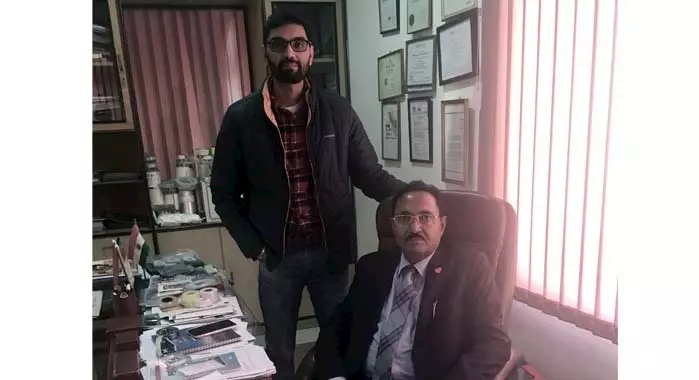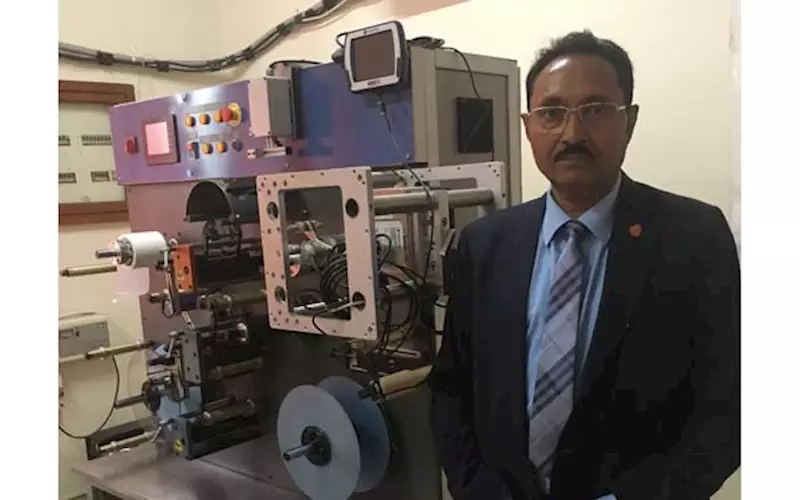Changing the VDP labels script in India
From an agency to distribute hosiery products to indulging in barcode and RFID labels, PC Jain, the chairman of Great Eastern ID Tech, sensed a plot twist or a turning point which changed the fortunes of his company. Harveer Sahni finds out
26 Feb 2018 | By Harveer Sahni
Nine years after a supermarket cashier in Troy, Ohio-USA, on the 26th of June 1974, scanned a barcode for the first time in history on a 67 cent 10 piece pack of Wrigley’s Chewing Gum, Prem Chand Jain popularly known as PC Jain, introduced variable data labels to India in shape of price marking labels. This was in 1983 as a precursor pioneering in barcode labels. Another seven years later in 1990 he yet again led the country’s indulgence in producing and using barcode labels.
In 1951, Norman Joseph Woodland and Bernhard Silver patented the barcode co-invented by them in the shape of conclavic rings of varying widths. Twenty years later in around 1971 George Laurer with support from Woodland, his colleague at that time in IBM, created the present day barcode.
Barcodes have eventually become an absolute essential in the modern day organised retail. The usage of barcodes that was initially limited to mega malls and retail stores have now found extensive usage in small local colony stores, industry, logistics, banking, travel and almost all segments of society.
RFID (Radio Frequency Identification), another invention whose history can be traced back to 1940 during World War II, has also found application in variable information labels in recent times.
Jain’s company Great Eastern Impex now renamed Great Eastern IDTech, heads the company as its Chairman. He has pioneered the introduction and proliferation of variable data labels in India.
The journey
Jain was born in a family of hosiery traders in the small town of Patti some 45 kms from Amritsar in Punjab. After initial schooling, the family moved to Ludhiana, the industrial town of Punjab.
Alumni of star college of Ludhiana, Jain took employment in a hosiery unit owned by the Oswal Group, where he worked for three years. He gained knowledge and experience of handling exports of yarn and imports of machinery, raw materials and equipment at a time when documentation and procedures were licensed, complicated and cumbersome. Coming from a family of businessmen, Jain decided to venture out on his own. In 1966 he took up an agency of few Ludhiana-based hosiery companies and for the next four to five years he sold their products to customers in the Middle East and North Africa (MENA) region countries.
Nostalgically he reminisces, “I used to carry two bags as baggage, one was always full of samples to demonstrate the offerings and book orders,” Jain says. “I would never leave any city until the letter of credit (LC) was established by the buyers who placed orders with him.”
There were times when he would even interact with buyer’s bank to expedite matters. Achieving a sale of Rs 500,000 at that time was a substantial amount with the exchange rate at just Rs 7.50 for one US Dollar.
By 1975, he had made some good earnings and indulged further by starting exports of T-shirts to UK, Germany and USA. However, when exports of these items became difficult due to quota restrictions imposed, he shifted focus. He started to import heat transfer presses and printing solutions to print on T-shirts. His biggest customer then was the makers of Smash T-Shirts that gave him enough money to buy his own office in central Delhi’s Rajendra Place.
Entry into VDP labels
In 1983 Jain started a partnership firm, Great Eastern Impex, where he came in contact with Harjit Singh Kochhar of Giggles gift shop in New Delhi’s Connaught Place.
“This was the starting point of my journey into the world of variable information printing labels,” says Jain.
For Kochhar, it started during one of his foreign trips where he bought a price marking hand labeller. When Kochhar ran out of labels, he requested Jain who was experienced in import procedures, to help him import labels.
Great Eastern Impex imported a full carton of price marking labels for Giggles from Monarch Marking Systems in the USA. “That was my first indulgence in labels,” says Jain.
The US-based company Monarch saw an opportunity in Great Eastern Impex and soon their sales person Cliff Cuttele landed in Delhi to meet Jain. Cuttele demonstrated the usage of labellers and how to open and load labels. “It was so interesting that we immediately headed towards Connaught Place to visit shops and assess the interest. Almost all customers wanted these machines,” says Jain.
It was during this trip of Cuttele that everything fell in place for Great Eastern to become Monarch’s exclusive agent in India.
In 1985-86, P C Jain and his brother in law decided to part company in business. Jain entered into a new partnership with his clearing agents Prem Khanna and Surinder Singh Bakshi. A financer joined hands in their new venture GEIPL (Great Eastern Impex) and became exclusive agents of Monarch Marking Systems USA for the next five years. They would import the Monarch labellers and labels and distribute them.
In 1986 A S Shekhawat who came from a publishing company joined GEIPL as a manager to expand their sales network and setting up dealership network across the country.
Manufacturing labels
In 1991 GEIPL entered into a technical collaboration with Monarch to manufacture and sell labels in India with a Japanese ITOH label press that was re-engineered by Monarch in the USA to their particular specifications to produce five different types of labels.
This press was supplied by Monarch to GEIPL under a royalty agreement of paying 5% on sales to their foreign partner. In 1992 Bakshi left the company leaving the reins of the venture in hands of Jain and Khanna.
In 1996 HSSIDC allotted to them a 2,100 square meter plot in Gurgaon on which GEIPl built their double storied 25,000 sqft factory building.
By 1990 barcode usage had surfaced in India and GEIPL had already made up their mind to indulge in it. At almost the same time Shobhana Shah Dharia, alumni of Wayen State University and working as a software engineer in Symbol Systems USA had migrated to Mumbai India. She launched barcode scanning technology in the country to make complete barcode solutions available.
With GEIPL being the first entrant in the trade to offer barcode labels and printers and Dharia offering scanning solutions, the Barcode, the technology was available in totality. The proliferation of barcodes started and by 1995 it was fully developed and is widely used. There were two organizations that were offering barcode symbologies that is EAN or European Article Number from Europe and UPC or Universal Product Code from the USA. GEIPL opted for adopting the European symbology.
The Indian Institute of Packaging (IIP) was identified by the Ministry of Commerce, Government of India, for the establishment of EAN India for the introduction of barcode technology for export in India. The then Director of IIP, P V Narayanan called a meeting in this regard and it was attended by Jain, Shobhana Dharia and Sameer Parikh of Intellicon.
It was decided to first form EAN India with a license from EAN Europe and supported by IIP and Ministry of Commerce. In 1990, the country code 890 was allotted to India followed by the manufacturer’s code. The typical configuration of a barcode is – the first three digits will be the country code followed by manufacturer’s code issued by EAN India and then the product code. The barcode becomes complete when the last check digit is added.
Eventually to bring global uniformity in language controlling barcodes business, in 2005 EAN and UPC merged to create one body called GS1(Global Standard1) worldwide.
In India, the business is controlled by GS1 India covering all Indian manufacturers from segments like retail, pharma, automotive, FMCG, cosmetics, liquor, etc.
By the start of new millennium, GEIPL had added another unit called Rachna Overseas (ROPL) in its fold. ROPL was formed with wives of Jain and Khanna as partners to produce thermal transfer ribbons for barcode printers and to be supplied to GEIPL. Sixteen years after being together as partners in 2002, Jain and Khanna, decided to split amicably. ROPL was taken over by Khanna while GEIPL remained with Jain.

A new company
Years later, Jain’s Shakti, fresh from his management studies at the Rochester School of Technology in 2001, joined Jain in the label business, and is now the managing director of GEIPL.
“Under Shakti’s leadership the company’s sales that had initially dipped after the division of assets among the erstwhile partners, has doubled.”
Carrying his father’s vision of moving ahead of time, Shakti foresaw that RFID labels will be the future. In 2012 Shakti and his wife Neha, who is now the executive director of the company, visited Spain to be trained in RFID technology and to see the RFID inlay insertion machine.
In yet another pioneering step the duo bought this machine and became the first Indian label company to offer RFID self-adhesive labels, and changed the company name to Great Eastern IDTech so as to project its modern approach and indicate their digital offerings.
The RFID plunge
Great Eastern has had steady and smooth operations however the only challenge came when the Jains took up a complete barcode and RFID project for Government’s warehouse management systems. The younger Jain says, “We had estimated to complete the project in three months and it kept on getting delayed due to technical issues. Persistent efforts helped us achieve success in implementing the systems in one year.” Sales that fell to Rs 10-crore after the split between partners in 2002, after achieving a steady growth over the following years, is expected to reach Rs 32-crore in 2018.
Great Eastern IDTech’s biggest order came when they supplied, installed and commissioned 2,500 barcode printers to HDFC Bank in all their branches, some in distant places.
Great Eastern IDTech now has its manufacturing facility spread over 25,000 sqft with 135 employees with five offices in Bengaluru, Chennai, Pune, Mumbai and Kolkata besides the head office in Gurgaon.
Two-third of the company’s business comes from consumables and one third from hardware and software. Barcode technology accounts for 85% of sales, RFID 5% and price marking is 10%. The company sells 2-lakh sqm of thermal transfer ribbon per month, converts 150,000 sqm of label stock per month and sells one million RFID labels per year. Visualising future the father-son duo expresses that by the year 2020, they will reach a turnover of Rs 50-crore just by organic growth.
The recognition
In progressing years Jain has tried to give back to the industry and society that gave him success and recognition. He is involved with many charitable institutions. He initiated the formation of AIDC (Automatic Identification & Data Capture) Association of India and was its founder president for the first two terms of three years each.
The association began with just 30 members and has now grown to 150 members with pan-national presence.
In 2012 the AIDC Association at its annual conference in Kovallam resort Kerala, conferred upon Jain the “Lifetime Achievement Award”.
Written by Harveer Sahni, chairman Weldon Celloplast, New Delhi











 See All
See All